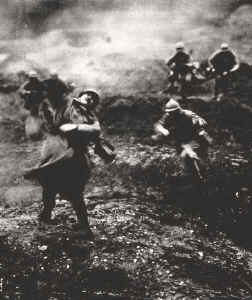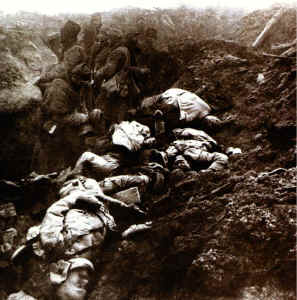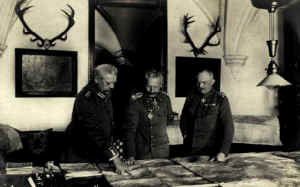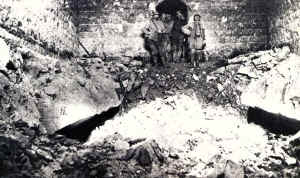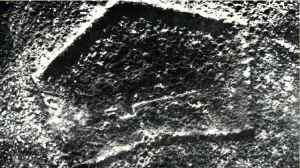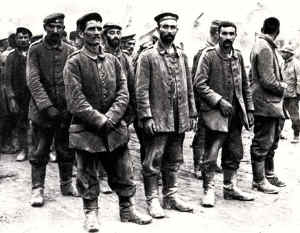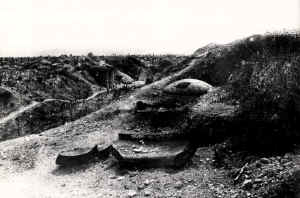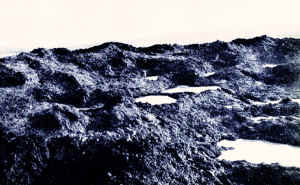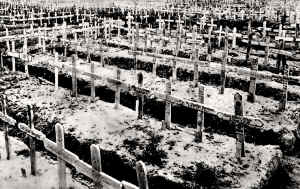| Homepage Verdun - Phase 1 - Phase 2 - Phase 3 - Phase 4 - Phase 5 - Phase 6 | ||||||||||||
|
|
||||||||||||
|
Phase 6
- The French offensive (21 October - 19 December) |
||||||||||||
|
|
||||||||||||
| Content
- The French offensive Introduction The relief of Knobelsdorf and Falkenhayn The fall of Fort Douaumont and Fort Vaux The last French offensive |
||||||||||||
|
|
||||||||||||
|
The Battle of Verdun is considered the greatest and lengthiest in world history. Never before or since has there been such a lengthy battle, involving so many men, situated on such a tiny piece of land. The battle, which lasted from 21 February 1916 until 19 December 1916 caused over an estimated 700,000 dead, wounded and missing. The battlefield was not even a square ten kilometres. From a strategic point of view there can be no justification for these atrocious losses. The battle degenerated into a matter of prestige of two nations literally for the sake of fighting...... |
||||||||||||
|
|
||||||||||||
|
In order to lift spirits general Lochow
orders to be very strict when cowardliness and insubordination occur; more
than once there are instant executions. Wednesday - 23 August The German headquarters at Stenay receive the
message that General Knobelsdorf is going to be relieved of his duty. He
is held responsible for the failed Verdun offensive, which is threatening
to end in defeat. Criticism at Falkenhayn is increasing as well. He is
held accountable for the fact that the Verdun battle, which was intended
to bleed the French to death, has turned into a mincer, which grinds in
its machine the German troops and artillery as well. This eventually
causes all offensive possibilities to fail.
After being persuaded by the Crown Prince the first measure General
Ludendorff takes is ending the German activities at Verdun, unfortunately
the taken course cannot be given up. The French are not even considering
stopping the battle. They continue to attack German fortifications, which
are usually difficult to defend and this is the reason the Germans suffer
more losses than the French. Saturday - 21 October The French attack starts a bombardment with a lot of strong calibre on a frontal width of 7 kilometres. At the same time Fort Douaumont is taken under fire with the new 400-mm guns; the bombardment is directed from a reconnaissance plane which is circling above the fort at that time.
The following day the French artillery suddenly falls silent. Monday - 23 October Both Creusot-Schneider guns start to fire again at Fort Douamont. Two perfect hits penetrate the core of the fort and cause enormous damage. The lights stop shining and the second hit kills all that are present in the military hospital. Also a fire starts. Unfortunately, grenades make numerous victims. There are many wounded and poisoned with gas and the troops start to panic.
The German Commander decides to evacuate the fort. A small occupying force
stays behind in the fort, under the command of Captain Soltau. At his
request to send reinforcements he receives no response and because he
cannot defend the fort with just a few soldiers, he decides to evacuate
the fort. Among the first group that left the fort was Captain Prollius
who makes the decision to return to the fort because he considers it wrong
to hand the fort over to the French without a fight. After close
inspection the fort seems to be free of gas and the fires seem to be under
control. With no more than twenty hastily assembled men he decides to
occupy Fort Douaumont once again.
At some places the Germans stand firm, for example at Haudromont, mainly because of the strategically placed machine-gun nests. The taking of Fort Douaumont is placed in the hands of the Regiment d’Infantery Coloniale du Maroc, under the command of Nicolaï. After a brief encounter Captain Prollius decides to hand the fort over to Major Nicolaï. The Germans loose their most important base at the Verdun front.
(Note: during these days before the French attack 240,000
grenades are fired per day; on an average day this number is 100,000. In
the previous seven months the French have used an estimated 23,000,000
grenades.)
Wednesday - 25 October Fort Vaux is attacked. The first French wave
of attacks is gunned down by the German machine-gun fire. Without mercy
the French Commanders organise two more attacks without any artillery
support and again the French collapse under the murdering machine-gun
fire.
General Ludendorff is in strong favour of withdrawing the troops from
front situations, which no longer have a strategic purpose, to be able to
avoid unnecessary losses. It is decided to evacuate Fort Vaux and to
destroy it. Following the fall of Fort Vaux it remains silent at the front for several weeks. In the meantime General Nivelle has been appointed Supreme Commander of the French army and General Mangin Supreme Commander of the Verdun front. Mangin decides to attack one more time to force the Germans back to their original position of February 1916.
Monday - 11 December The French shelling start again in all
intensity and on Wednesday 13 December the creeping barrage becomes
operational again. Still the Germans do not surrender.
German reinforcements that have arrived in a hurry are standing firm in
a line which exists of inter-connected shell holes in which the Germans
are standing, shivering in freezing cold water that comes up to their
knees.
Tuesday - 19 December The German army Command reaches the
conclusion that at Verdun a complete defeat had been suffered. More than
11,000 German soldiers and officers have surrendered; they often did not
even come out of their shelters to fight anymore. At that date the German army is
definitively thrown back in its original positions. The Battle of Verdun
has come to an end.
|
||||||||||||
|
|
||||||||||||
| Homepage Verdun - Phase 1 - Phase 2 - Phase 3 - Phase 4 - Phase 5 - Phase 6 | ||||||||||||
|
|
||||||||||||
|
|
